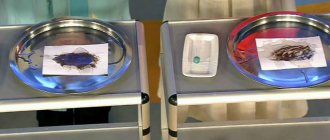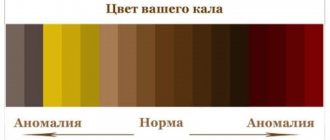Blood during bowel movements is a multivariate sign of many diseases. There is no reason to worry if such a deviation from the norm was a one-time occurrence. If there is a tendency for repetitions and development, it is better to consult a doctor to find out what this is a sign of: a serious systemic pathology or a temporary digestive disorder. Let's consider the occurrence of the symptom, its varieties, and detection methods.
Causes of blood in stool
The etiology of the unpleasant condition depends on the nature of the bleeding and the location of its source. The further it is from the anus, the darker and thicker the bloody discharge will be. The reasons for changes in the color and consistency of biological fluid are associated with its partial coagulation, which occurs as it moves through the digestive canal. The feces are foul-smelling and look like tar.
Bright scarlet drops on top of the stool or smeared on toilet paper are observed if hemorrhoids or the anal mucosa are damaged. This is the most harmless form of the symptom in question.
The following signs indicate a dangerous disease:
- Blood is dissolved in the stool.
- It is released in clots or streams during defecation.
- The stool contains pus and/or mucus.
Circumstances aggravating the general condition include:
- Vomit.
- Fever.
- Pain during bowel movements.
Tarry feces are a sign of a number of pathologies, including:
- Haemorrhoids.
- Proctitis.
- Cancer.
- Enterovirus infection.
- Helminthiases.
- Salmonellosis.
- Dysentery.
- Diverticulosis.
Bloody stool may appear as a result of radiotherapy sessions
, which negatively affects the vessels of the digestive canal. The symptom is possible in an adult man whose prostate gland has been irradiated. Endometriosis is indicated by blood released from the rectum during menstruation.
The mucous membrane of the digestive canal can be injured due to alcohol abuse, prolonged use of antibacterial agents that disrupt the balance of microflora in the intestines. As a result, an allergy develops that provokes the release of blood during bowel movements. A similar symptom is observed during chemotherapy performed using cytostatics.
Prevention
Preventive measures include timely diagnosis and the appointment of adequate treatment for the pathological process in the body. Also organize proper nutrition to prevent bowel movements.
FAQ
What to do if there is blood in the stool?
If you have bloody stools, consult your doctor to determine the cause. The doctor refers the patient for a comprehensive examination and, based on the results obtained, prescribes treatment.
What examinations need to be completed?
Laboratory diagnosis is required. Recto- and anoscopy are also prescribed to determine pathological changes in the intestinal mucosa.
You can see prices for services
When self-medication is dangerous
A serious condition is indicated by constant scarlet discharge. The doctor will make an accurate diagnosis based on the results of laboratory and instrumental diagnostics.
Urgent hospitalization will be required if, along with this, the patient has:
- Nausea, vomiting with blood.
- Hematomas that occur without tissue injury.
- Weakness, confusion.
- Pain in the abdominal area.
- Fever.
In such cases, attempts to cope with the problem on your own are unacceptable. The desire to wait for a doctor’s consultation at the clinic also poses a threat to the patient’s life.
After relief of dangerous symptoms, an examination is prescribed to identify the cause of the condition. The further treatment regimen will be determined by a specialist of the appropriate profile.
Treatment
All diseases in which bloody stools are observed require medical attention. If this symptom is detected, you must contact a proctologist or surgeon and undergo an examination. Based on the results obtained, the doctor will prescribe treatment.
Surgical
If necessary, doctors at the Yauza Clinical Hospital perform endoscopic, laparoscopic or abdominal operations to remove tumors, ligate (ligate) bleeding vessels, and laser coagulate them.
Conservative
Conservative treatment at the Yauza Clinical Hospital may include:
If blood appears in the stool due to hemorrhoids or fissures, then conservative treatment methods are often sufficient. Drug therapy is aimed at eliminating pain and spasm of the sphincter. Medicines that normalize stool are also prescribed. The need for enzymatic support arises only in case of lactose deficiency and allergy to cow's milk proteins.
Infectious diseases
Large-scale internal bleeding is caused by damage to the body by parasitic protozoa (dysenteric amoeba) and pathogenic bacteria (typhoid fever). The cause of the symptom may be rotavirus, which irritates the intestines and causes erosive damage to its mucosa. Infections are highly lethal and therefore require urgent medical intervention in a hospital setting.
Bleeding of damaged surfaces, as well as anemia, are accompanied by helminthic infestations that violate the integrity of the mucous membrane of the digestive canal. In addition, with helminthiasis, the functions of internal organs weaken, immunity decreases, allergies appear, and an abundance of diseases of a bacterial and viral nature develop, which require specific treatment. Exacerbation of parasitosis is accompanied by bleeding from the anus.
Parasites
Another reason for the appearance of intestinal bleeding in men is helminthic infestation. Nematodes, whipworms, as well as pork and bovine tapeworms can be found in the body of the sick person. Most often, the culprits of bloody impurities in feces in this case are considered to be roundworms - helminths that pose a serious threat to the human body. Such worms can parasitize in any human organ, but their localization is mainly in the small intestine. Answering the question: “Why does blood appear during bowel movements?”, it should be noted that, reaching a length of 15 to 22 cm, these helminths affect blood vessels and capillaries, and this already leads to unnatural impurities in excrement.
When infected with worms, blood is excreted in small quantities in the feces of men. Its color is in most cases dark. The patient also experiences other bowel disorders, abdominal pain, skin rashes, and weakened immunity.
Diseases of the rectum
Blood in the stool is a symptom of pathologies in the lower digestive canal. Its inflammation (proctitis) can be acute or chronic. Accompanied by pain in the perineum and abdomen, malaise, frequent urge to defecate, and fever.
The causes of scarlet blood not mixed with stool are as follows:
- Anal fissures accompanied by profuse, painful discharge. After heavy physical activity, their traces can be found on underwear. The treatment uses ointments, compresses, rectal suppositories with anti-inflammatory and wound-healing effects.
- Polyps. To avoid malignancy of growths, their timely surgical removal is practiced.
- Tumors (benign or malignant).
- Chronic form of hemorrhoids.
Additional factors associated with rectal bleeding include:
- Pregnancy.
- Frequent constipation.
- Hard physical labor.
- Stress.
Blood on toilet paper appears during anal sex and poor personal hygiene.
Blood in the stool (medical: hematochezia, melena) is seen by most patients as something terrible. If you notice blood in your stool, you don’t have to worry about the worst, but you should immediately consult a doctor. Possible causes of blood in the stool include gastrointestinal infections, colon polyps or hemorrhoids, stomach ulcers or chronic inflammatory disease of the large intestine. To exclude the diagnosis of malignant diseases - such as intestinal cancer - it is necessary to immediately conduct appropriate research in the clinic. Below you will learn all the important information about the “blood in the stool” symptom.
Blood in the stool: Description
Blood in the stool indicates that the body is losing blood somewhere inside the gastrointestinal tract, which is then found mixed in the stool. The color and consistency of mixed blood can serve as an almost reliable indication of where the source of bleeding is located.
Blood in stool does not necessarily appear as a bright red or dark red coating or impurity; in fact, it can turn the stool black. The corresponding manifestations depend on the level of bleeding in the digestive tract, since the state of the blood changes upon contact with gastric juice and as a result of processing by microorganisms.
Red blood in the stool (hematochezia)
If the blood in the stool is bright red or dark red, in the form of impurities or streaks, then the blood is relatively fresh. This type of blood in the stool is called hematochezia. The source of bleeding is most likely in the middle or lower parts of the gastrointestinal tract (GIT), because the blood could not be destroyed in large quantities either by the hydrochloric acid of the stomach or by bacteria.
If the stool is uniformly dark red, this may indicate, for example, major bleeding in the large intestine. With minor bleeding, jelly-like traces of blood are observed in the stool.
In turn, light red stripes may indicate fresh bleeding in the rectal area, for example, with hemorrhoids.
Black blood in stool (melena, tarry stool)
If the stool is black and shiny, then we are talking about the so-called tarry stool (melena). When bleeding in the upper gastrointestinal tract, that is, from the esophagus to the duodenum, hemoglobin in the blood breaks down into hematin upon contact with gastric juice. This hematin is the cause of black stools, and in cases of vomiting, the vomit may resemble coffee grounds.
Black stool most often indicates that the source of the bleeding is higher than the small intestine and is caused by either a stomach ulcer or bleeding in the esophagus.
Since intestinal bacteria, with prolonged contact with blood, also cause the breakdown of hemoglobin into the pigment hematin, black stool may not necessarily be a consequence of bleeding in the upper gastrointestinal tract. When the passage of chyme (intestinal contents) is slow, melena can be caused by bleeding located deeper.
Under certain circumstances, high-lying bleeding in the gastrointestinal tract, on the contrary, can lead to hematochezia, both when the secretion of gastric juice decreases due to medication, and in case of severe bleeding, when chyme quickly passes through the intestines.
Hidden blood in stool
It may also be that although there is blood in the stool, it is not visible. Then we are talking about hidden blood. In most cases, it is discovered incidentally during a routine examination or during a targeted examination of known damage to the digestive tract.
Since blood cannot be detected with the naked eye, a guaiacol test for detecting blood in stool (hemoccult test) is used, which can detect even small quantities.
Cases that are confused with the presence of blood in the stool
After eating certain foods, your stool may look like there is blood in it. This is caused by the consumption of red beets, which stain the stool dark red, which occurs with hematochezia. Blueberries turn the stool black, similar to licorice, so that when examined, it is perceived as melena.
Also, some medications can cause black stool (for example, activated charcoal or iron supplements).
Blood in the stool: Causes and possible diseases:
Various possible reasons for the appearance of blood in the stool, causing bleeding in the gastrointestinal tract, are being considered. These include bleeding from the oropharynx, esophagus, stomach, small and large intestines and anus. In principle, bleeding can occur in every department, with the frequency and significance of different causes varying.
Blood in the stool due to bleeding in the upper digestive tract
- The most common cause of bleeding in the upper digestive tract is ulcers in the stomach and duodenum, often caused by Helicobacter pylori bacteria or long-term use of certain medications, such as aspirin.
- Chronic heartburn can, when gastric juice gets in, lead to inflammation of the esophagus (reflux esophagitis) and, as a result, bleeding.
- With certain liver diseases, a redistribution of venous blood flow occurs, which causes varicose veins of the esophagus. Such dilated veins easily rupture and lead to severe, often life-threatening bleeding.
- After profuse vomiting, extended tears of the mucous membrane may occur at the junction of the esophagus and the stomach. Then we are talking about Mallory-Weiss syndrome, often found in alcoholics who have previously had damaged mucous membranes.
- Finally, blood in the stool can also be a likely symptom of stomach cancer.
- In the middle sections of the digestive tract, the most common cause of bleeding is tumors of the small intestine. Also in the large intestine, atypical growths can lead to the appearance of blood in the stool. They do not have to be malignant.
- Particularly in young patients, chronic inflammatory bowel diseases such as Crohn's disease or ulcerative colitis can cause bleeding. If in the latter case only the colon and rectum are affected, then in Crohn's disease the entire gastrointestinal tract [can] be affected. The exact causes of both diseases are unknown.
- Polyps are most often benign growths of the large intestine that usually do not cause any problems, but as their size increases, the risk of bleeding also increases. They can also develop into pre-cancerous conditions, so after a certain size they are mostly removed. The consequence of such interventions, in turn, may be secondary bleeding.
- With diverticula, we are talking about protrusions of the walls of the intestinal wall, which, when viewed from the inside, are small “pits”. Diverticula most often form and are found in the large intestine. Depending on the circumstances, they can become inflamed (then we are talking about diverticulitis) and cause bleeding.
- Various intestinal infectious diseases, ranging from common gastroenteritis to severe diseases such as typhus or dysentery, can cause blood in the stool, most often in combination with diarrhea. Also, excessive proliferation of bacteria that make up the natural intestinal microflora, for example, after [a course of] antibiotic therapy, can cause hematochezia. An example is pseudomembranous colitis.
- Bright red blood in the stool often occurs with hemorrhoids. This usually refers to a pathological increase in arteriovenous anastomoses under the rectal mucosa. During defecation, they are often damaged, resulting in a coating of fresh, often bright red blood.
- Elderly people often experience so-called mesenteric infarctions, that is, blockage of intestinal vessels. If the tissues of the affected areas are damaged, subsequent bleeding may occur.
Blood in the stool due to bleeding in the middle and lower parts of the digestive tract
Blood in the stool: When should you see a doctor?
If you find blood in your stool, you should consult a doctor in any case. Despite the fact that most bleeding stops on its own without medical help and is often not dangerous. It is still necessary to find out where the source of the bleeding is and whether there is a more serious disease behind it. Especially if you have other symptoms, such as:
- Pain in the stomach and abdomen.
- Pain during bowel movements.
- Nausea and vomiting (including in the presence of blood in the vomit).
- Prolonged lethargy and fatigue.
- Pronounced weight loss in a short time.
- Night sweats.
You can't put off visiting a doctor.
If there is severe bleeding in the digestive tract after a certain period of time, anemia (anemia) may occur due to blood loss, which in any case requires treatment.
Blood in the stool: What does the doctor do?
If blood in the stool is caused by acute bleeding in the gastrointestinal tract, resulting in severe blood loss, it is necessary first of all to replace the missing blood volume. If left untreated, in worst cases it can lead to spinolaemic shock, a life-threatening condition.
The patient is placed in a supine position, receives oxygen through a nasal tube and, as soon as possible, a blood substitute to replenish lost blood volumes. In case of large blood losses, blood transfusions are also performed.
Also, with chronic bleeding in the gastrointestinal tract over a long period of time, anemia may develop, the treatment of which is similar [to the treatment of acute blood loss].
History and investigations
If a patient consults a doctor complaining of blood in the stool, in most cases the location of the bleeding is unknown and must be determined.
Medical history data can provide valuable guidance. For example, it may be important whether there has been blood in the stool before. It should also be clarified whether there were previously hemorrhoids, peptic ulcers, chronic inflammatory bowel diseases, alcohol abuse or diverticula, that is, whether there are risk factors for gastrointestinal bleeding. Next, studies are carried out to detect the source of bleeding.
- Of great importance in this case is gastroendoscopy, in which a gastric tube (gastroenteroscope) is inserted through the mouth and allows the doctor to assess the condition of the esophagus, stomach and duodenum using an endoscope. When examining the large intestine (coloscopy), the endoscope is inserted into the rectum and can be inserted down to the final part of the small intestine. Using these examination methods, many possible causes can be detected, such as diverticulum, chronic inflammation, ulcers, esophageal varices, colon polyps and other growths. Rectoscopy is most often used to examine hemorrhoids. Although the nature of the blood in the stool, as well as possible previously established diseases, can indicate the location of the source of bleeding, it is still better to use gastroduodenoscopy, especially in cases where the specific lesion cannot be identified.
Since gastroduodenoscopy cannot always determine the source of bleeding and, in addition, it is not always possible to obtain sufficient data, in such cases additional research methods are used.
- Double-balloon enteroscopy allows you to examine the condition of the small intestine. In this case, two balloons attached to the endoscope are alternately inflated so that they can be advanced along the length of the endoscope. This study is usually carried out in two stages - examination of the upper part of the small intestine with insertion of a probe through the mouth, and the lower part through the anus.
- Meanwhile, it is also possible to perform video capsule endoscopy. In this case, the patient swallows a mini-camera, which takes pictures at certain intervals. This way the small intestine is examined. However, this method takes time and does not allow precise localization of the source of bleeding.
- Ultrasound can help identify blockages in blood vessels as a possible cause of blood in the stool.
- Further, nuclear medicine techniques and selective arteriography can be used, which can detect only active bleeding.
- If it is suspected that the cause of blood in the stool is an infection, an attempt is made to identify the corresponding pathogen using stool and blood cultures.
Therapeutic measures
Treatment depends on the cause of the bleeding. First of all, you should, of course, stop active bleeding, then you need to prevent recurrent bleeding by fighting the cause.
In order to stop active bleeding in the digestive tract, various endoscopic techniques are first used. It is advisable that if the source of bleeding is detected during gastro- or colonoscopy, the cause of the bleeding can also be eliminated using one of the following methods:
- bleeding can be stopped, for example, with a hemoclip - a type of clamp that compresses the affected area.
- There are also injection techniques, in which a solution of adrenaline is injected into the site of bleeding with a needle, which compresses the blood vessels, or so-called fibrin glue can be injected.
- It is possible to use a laser to cauterize the bleeding site.
- The source of bleeding can be cut out microsurgically.
- In the case of esophageal varices and hemorrhoids, latex ligation is often used.
When the bleeding has stopped, treatment begins to eliminate the cause of the disease:
- For peptic ulcers, an attempt is made to reduce the production of stomach acid with the help of certain medications (proton pump inhibitors, PPIs), and dietary therapy can also be carried out. In case of Helicobacter pylori , a combination of various antibiotics is used.
- The cause of varicose nodes in the esophagus is high pressure in the portal vein system, and therefore they try to reduce it with the help of medications (beta blockers, spironolactone).
- Chronic inflammatory bowel diseases require special treatment, using anti-inflammatory drugs - glucocorticoids.
- Diverticulitis is treated with antibiotics. If this is no longer possible, the affected area of the intestine is removed.
- Intestinal polyps are also usually removed.
- For malignant diseases, surgery, chemotherapy and radiation therapy are considered.
How to contact us
Email: Tel.: +49 212 5476913 Viber | WhatsApp: +49 173-2034066 | +49 177-5404270 For your convenience, please save the phone number in your phone book and call or write to us for free on WhatsApp, Viber or Telegram. Applications made on weekends or holidays will be processed on the first business day.
Colon diseases
Bleeding from the anus is often a sign of colitis. Inflammation is accompanied by:
- Fetid odor of feces.
- Pain of a wandering nature.
- Flatulence and problems with stool.
The cause may be a violation of the usefulness of the intestinal microflora (dysbacteriosis). In this case, the clinical picture is complemented by:
- Nausea.
- Flatulence.
- Constipation.
- Diarrhea.
- Bad breath.
Bleeding from the anus is characteristic of colon cancer, and the color of the inclusions can vary: from bright scarlet to black tarry, sometimes with clots. Constant symptoms of cancer of the digestive canal include:
- Changes affecting the shape, consistency, thickness of stool.
- Bloating.
- Weakness and weight loss.
- Iron-deficiency anemia.
- Feeling of not emptying the bowels.
Sample collection
Figure 1. Hemoccult slide
Prepare everything you need
You will need the following:
- Hemoccult® slide;
- applicator stick;
- clean dry container;
- trash bin.
Instructions
- Prepare everything you need. Place all items in the bathroom so that you can easily reach them.
- Remove the Hemoccult slide from the paper envelope. Set the envelope aside.
- Do not place the Hemoccult slide and applicator wand on the edge of a sink, bathtub or toilet. They cannot be wet.
- Keep Hemoccult slides at room temperature away from heat and light.
- Check that the card contains your name, date of birth and medical record number. If this information is not listed on the card, write it down.
- Fold down the large front flap of the Hemoccult slide. You may notice a light blue discoloration of the paper in the squares above fields A and B. This will not affect the test results.
- Sit on the toilet as usual to have a bowel movement (big pee). Use a clean, dry container to catch the stool before it touches the toilet water.
- Using the end of the applicator stick, take a stool sample. Place a thin smear of stool inside square A on the Hemoccult slide (see Figure 1).
- Using a stick, take a second sample from another part of the stool. Apply a thin smear of stool inside square B.
- Throw the stick in the trash.
- Close the flap of the Hemoccult slide and place it back into the paper envelope. Do not put it in waterproof packaging such as a plastic bag. Store it at room temperature away from light, children and pets.
- Dispose of the contents of the stool container into the toilet. Flush the toilet.
- Wash your hands. Wet your hands with warm water and scrub them with soap for at least 20 seconds. Rinse your hands.
Repeat these steps to collect samples on days 2 and 3. Write the date of collection next to each sample.
to come back to the beginning
Blood streaks in stool
Regardless of the consistency of the stool, red “threads” in its composition indicate inflammation in the digestive canal. Provocateurs of the phenomenon can be:
- Parasites.
- Imbalance of microflora.
- Stomach flu.
- Dysentery.
The symptom cannot be ignored, especially if it is accompanied by loss of appetite, sudden weight loss, and nagging pain in the abdominal area. After all, streaks of blood can also be a manifestation of Crohn's disease, a tumor process, bleeding polyps, and diverticulitis. If you consult a doctor in a timely manner, the chances of a full recovery increase.
Blood color and diarrhea
When veins or clots of biological fluid appear, you need to pay attention to their color and quantity. During examination, this information is reported to the doctor, as this makes it possible to suggest the cause of the pathological process and speed up diagnosis.
| Color, quantity | Possible reason |
| Scarlet. | Injury. Haemorrhoids. Cracks in the anus, rectum. |
| Black, black clots. | Upper parts of the gastrointestinal tract. |
| Black in large quantities. | An open or perforated ulcer in the upper gastrointestinal tract. |
Tests for occult blood in stool
A painless, safe immunochemical method that detects hemoglobin when red blood cells are not visually detected under a microscope. A week before the test, in consultation with the attending physician, stop taking laxatives, as well as medications containing bismuth and iron. 3 days before the procedure you should not eat apples, liver or meat. The session can be carried out only 2 days after radiography of the digestive canal. Enema is prohibited the day before.
The stool should not contain urine or menstrual fluid. The biomaterial is collected during spontaneous bowel movements and delivered to the laboratory on the same day.
If the test result is positive, the patient is examined further until the cause of the condition is identified. If negative, against the background of non-disappearing symptoms, occult blood is determined again. If necessary, other more informative methods of instrumental and laboratory diagnostics are prescribed.











